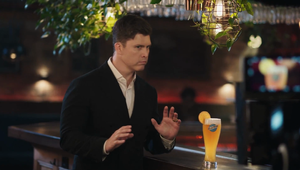
The Intertwined Intricacies of Communicating in Colour

The symbiotic relationship between DP and colourist is one that must be nurtured. There is an intricate art to deciphering a story’s visual identity which requires a connection that cannot be faked or forced. Separating one from the other is pointless, according to Pat Scola – because one informs the other, entangled in a creative double helix.
Those who view colour grade as merely a final part of the process designed to elevate the aesthetic is overlooking the importance and influence the craft has on the story itself. After all, the grade can push the viewer to feel a certain way as soon as a scene begins, and with that effect, you can mislead on purpose, or hold their hand along the way.
Blacksmith colourist, Mikey Pehanich has finessed the art of syncing up with his DP and long time collaborator, Pat Scola’s creative vision, giving work the final push that it needs. Having recently finished two new films - Sing Sing and We Grown Now, both of which premiered at this year’s Toronto International Film Festival - Mikey and Pat sit down with LBB to dissect the synergy of their working relationship.
LBB> How do you take into account the scene, dialogue and mood when working on the grade?
Pat> Well, I don’t think these things are “found” in the grade. These intentions are set long before we roll a camera. However, the colourist is a massive part of helping a DP actualise those intentions – both in prep and in finishing.
On ‘We Grown Now’ Mikey and I shot a bunch of tests on film, side by side, with the Mini LF. The goal was to find an overall show LUT that we were happy with on the film, then attempt to translate that to the digital sensor. We came up with a LUT called Gator, after Mikey’s dog. I believe we had about 5-6 variations of Gator that became the base contrast and colour levels for the entire film. Even though each scene has its own lighting and mood that reflect the story we are trying to tell, Gator was a huge part of how those aesthetics are rendered on screen.
Mikey> Oftentimes, when working with Pat, even prior to seeing any actual footage out of the can, we've already had several conversations on the grade. I really loved the process of building the LUTs on the set of ‘We Grown Now’; it opened the door to a lot of creative conversation that we ultimately saw when we got to working on the entire film, and it meant we weren't starting from scratch, which allowed for more creative freedom.
LBB> Collaboration between DP and colourist is a close one. What does a good professional relationship look like to you? What makes for a successful collaboration?
Pat> Communication, trust, taste. There are loads of talented colourists out there, really brilliant artists, but ultimately it’s about how the two of you see the world and are able to express that to one another. When you can communicate openly, safely, and not be afraid to go places that are bad - discovering the limits together - that’s the best type of collaboration. If I feel uncomfortable with a colourist as a human, the work often suffers.
Mikey> Communication first and foremost, for sure. Colour is so subjective so being able to speak the same language with DP's is key. Personality and taste is also a large part of it: being able to connect over any piece of film is always an added bonus.
LBB> Like all relationships, not everything always runs smoothly. What are some of the challenges that can come up if this relationship is not carefully nurtured?
Pat> Being able to talk about things you are unhappy with in a constructive way. Being honest, especially about something you don’t like, is the key. I’ve noticed creative relationships fall apart when people regret the choices they’ve made, and to me, that stems from not voicing honest opinions. Sometimes you have to come in and start from scratch, so it’s just about being able to do that in a healthy, positive way together.
Mikey> I guess I'd circle back to my point about communication. Being open to feedback and figuring out how to get to where you both want to be, together, is crucial. A lot of times it's a process of seeing what doesn't work or maybe pushing something and then taking a step back and re-assessing if it's working or it isn't.
LBB> You’ve worked together a lot over many projects. Tell us about some of your favourite joint pieces of work. What made them special?
Mikey> The first job that Pat and I ever did together was a commercial for Mercedes, titled 'Plushie' – this has always been a standout for me. It was just a really fun job to work on and the crew at Blacksmith crushed it. Audi with Sam Pilling and Shane Reid is a definite stand out, as well as Giveon with Salomon Ligthelm.
However I'd say the real trophy is ‘Sing Sing’, the film we just premiered at TIFF which is directed by Greg Kwedar. Pat reached out to me early on, well before he started shooting, and gave me the heads up that it was coming and that it was going to be a special one. I won't say too much more because I just want everyone to see it. The film moved me in so many ways and still continues to. It was truly a pleasure to work with Pat, Greg, and every single person attached to it.

Pat> We just premiered ‘Sing Sing’ at TIFF and I can’t wait. The cast is made up of formerly incarcerated actors and is fairly biographical in nature: a lot of folks sharing their history, their stories, their lives. It’s not traditionally “beautiful”, but it’s honest and real. After watching the film, there was this sort of unspoken agreement to do less. I found us both understanding that we just wanted to get out of the way of what we captured. There were situations where we could have done “more” in the film, but we both understood that easing off the gas was more important for the film as a whole.
LBB> Tell us about your personal creative processes and how they complement each other
Pat> We are both capable of seeing something for what it is and knowing which direction it should go in, without trying to change the DNA of it. Sometimes we should be doing almost nothing. As simple as that sounds, it’s not easy to find collaborators who understand that. Not being afraid of how the simplicity of things can look – Mikey understands that. He knows that sometimes less is more, and other times, he’s rescuing my footage from being embarrassed.
Mikey> I'd say at this point in our careers there's certainly a trust between us, and I'm very grateful for that. One thing I love about working with Pat is the ability to connect on what feels right pretty quickly. We certainly have chats and share references with each other, but once we get into the thick of it we get there quickly. We've developed a synergy that makes working together pretty seamless.
LBB> What do you most value about working together?
Pat> That it always feels like we’re discovering together.
Mikey> The banter. Aside from working on beautiful images with Pat, we're always laughing or chatting shit, and that's everything to me when we're in session. It's a lot of time to spend in a dark room so being able to have that chemistry is really special. Also, we always have the best tunes on – Title Fight's ‘Floral Green’ album to be more specific.
Above all else… Pat’s care for the work has always meant a lot to me. No matter how big or small the project, he puts in 100% which has always pushed me creatively – being able to feed off that energy helps push everyone to excel.
Pat> Our music is always right in the shop, hat can be a lot harder than you think.
LBB> What shorthand work flow have you developed over the years and how does that help / enhance the process?
Pat> This is an interesting one. Language is so important when collaboratively working on anything subjective, colour in particular. Mikey and I have done so much together, we have a common library of terms that describe things that aren’t always “technical”, but are more related to feelings and emotions. We rarely are saying things like “That’s too dark, or “That’s too bright”- we’d likely say something like “It needs more snap” - which kind of translates to the higher end of the mid tones/low end of highlights, needing more contrast and separation from the lower end of the mid tones in a darker scene. We have a bunch of nonsense like this, that honestly saves loads of time if you add it all up.
Mikey> This is probably more extensive than I think because of how much we've done together. Pat and I have certainly developed a lingo that we both understand but maybe other people wouldn't necessarily which I think is quite dope. "Snap" is a popular one; it refers to a bit of midtone to highlight contrast that we normally do at the end of the node tree. Being able to have this sort of language/dialogue with one another certainly expedites our process because we aren't having to question what one another is referring to. Pat also loves a laser pointer.















